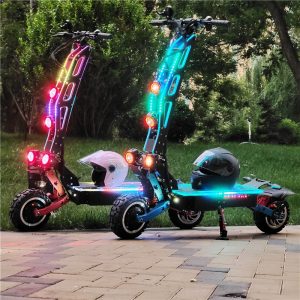Electric Step: The **Sexual Technology of the Future of Travel
An electric pedestrian, also known as an electric bicycle (e-bike) or an electric power-assisted bicycle (e-scooter), is a means of transportation that combines elements of traditional bicycles and electric vehicles. This type of vehicle has been widely used and developed rapidly in the past few years. It not only occupies a place in urban transportation, but is also regarded as a green, convenient and sustainable way of travel in the future.
The working principle of an electric walker is relatively simple. It usually has an electric motor that provides extra power when the rider steps on the pedals to help the rider move forward. Some advanced electric walking bikes also have a built-in battery that can continue to output electricity after the rider stops pedaling, so that the vehicle has enough power to travel a certain distance.
The advantage of an electric walker is its environmental friendliness and convenience. They do not emit harmful gases and are truly zero-emission vehicles, playing an important role in mitigating global warming and improving air quality. At the same time, electric pedestrians are small in size and flexible in operation. They can easily travel through small alleys in the city and are very suitable for short-distance travel. Additionally, electric walkers are relatively low-maintenance, requiring only regular charging and occasional minor repairs.
However, there are also some issues and challenges with electric walking bikes. First, the noise issue of electric walkers is a common concern. Although many manufacturers have begun to adopt some silent technologies to reduce the noise of electric walkers, in busy cities, electric walkers may still cause interference to the surrounding environment and people’s lives. Secondly, the lack of endurance and charging facilities of electric pedestrians is also a problem. Although the range of electric walkers is constantly improving, their range is still relatively short compared to traditional cars. Moreover, many places do not yet have sufficient charging facilities, so the use of electric pedestrians will still be limited in some cases.
Despite these issues and challenges, the future of electric walkers is still very bright. With the development of science and technology and people’s emphasis on environmentally friendly travel, the design and performance of electric walkers will be further improved. For example, many researchers are working on developing more efficient battery technology to improve the range of electric walkers. At the same time, some cities are also actively building and improving charging facilities to encourage more people to use electric pedestrians.
Overall, electric walking bikes are a form of transportation with huge potential. They can not only help us solve urban traffic problems, but also provide us with a more environmentally friendly, healthier and more convenient way to travel. Although there are still some problems and challenges with electric walkers, I believe that with the development of technology and social progress, these problems will be solved, and the future of electric walkers will be brighter.
Electric walking bikes: defining a new way to travel
An electric pedestrian, also known as an electric vehicle or battery vehicle, is a two-wheeled vehicle powered by electricity. Its design is inspired by bicycles and motorcycles, but it is lighter and more convenient than both. Over the past few years, this new form of transportation has exploded in popularity around the world.
The emergence of electric pedestrians is a product of technological development. Its emergence gives us more choices, both from an environmental perspective and from a convenience perspective. Not only can electric walkers help reduce the stress of urban traffic, they can also help us reach our destinations more conveniently.
Compared with traditional fuel vehicles, electric pedestrians have many advantages. First, it is a zero-emission vehicle. Compared with traditional fuel vehicles, electric pedestrians do not produce any harmful exhaust gas or noise pollution. This makes it a very environmentally friendly way to travel. Secondly, electric walkers consume less energy. It uses electrical energy, and the generation of electrical energy does not rely on non-renewable resources such as oil or coal. Therefore, in the long run, the energy consumption of electric pedestrians is much lower than that of fuel vehicles. Finally, electric walkers are also less expensive to maintain. Because of its simple structure and low failure rate, the cost of repair and maintenance is much lower than that of fuel vehicles.
However, despite the many advantages of an electric walker, it also comes with some issues and challenges. For example, electric walking bikes usually have a shorter range, which limits their range of use to some extent. In addition, the charging facilities for electric pedestrians are not perfect enough, which is also an important factor hindering their development.
despite this…




